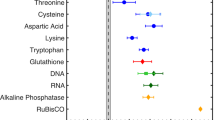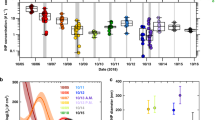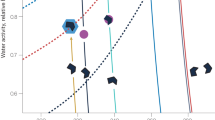Abstract
Ice particles in the atmosphere influence clouds, precipitation and climate, and often form with help from aerosols that serve as ice-nucleating particles. Biological particles1, including non-proteinaceous ones2,3, contribute to the diverse spectrum of ice-nucleating particles4,5. However, little is known about their atmospheric abundance and ice nucleation efficiency, and their role in clouds and the climate system is poorly constrained6. One biological particle type, cellulose, has been shown to exist in an airborne form that is prevalent throughout the year even at remote and elevated locations7,8. Here we report experiments in a cloud simulation chamber9 to demonstrate that microcrystalline cellulose particles can act as efficient ice-nucleating particles in simulated supercooled clouds. In six immersion mode freezing experiments, we measured the ice nucleation active surface-site densities of aerosolized cellulose across a range of temperatures. Using these active surface-site densities, we developed parameters describing the ice nucleation ability of these particles10 and applied them to observed atmospheric cellulose and plant debris concentrations in a global aerosol model. We find that ice nucleation by cellulose becomes significant (>0.1 l−1) below about −21 °C, temperatures relevant to mixed-phase clouds. We conclude that the ability of cellulose to act as ice-nucleating particles requires a revised quantification of their role in cloud formation and precipitation.
This is a preview of subscription content, access via your institution
Access options
Subscribe to this journal
Receive 12 print issues and online access
$259.00 per year
only $21.58 per issue
Buy this article
- Purchase on Springer Link
- Instant access to full article PDF
Prices may be subject to local taxes which are calculated during checkout



Similar content being viewed by others
References
Després, V. R. et al. Primary biological aerosol particles in the atmosphere: A review. Tellus B 64, 15598 (2012).
Krog, J. O., Zachariassen, K. E., Larsen, B. & Smidsrod, O. Thermal buffering in Afro-alpine plants due to nucleating agent-induced water freezing. Nature 282, 300–301 (1979).
Pummer, B. G., Bauer, H., Bernardi, J., Bleicher, S. & Grothe, H. Suspendable macromolecules are responsible for ice nucleation activity of birch and conifer pollen. Atmos. Chem. Phys. 12, 2541–2550 (2012).
Murray, B. J., O’Sullivan, D., Atkinson, J. D. & Webb, M. E. Ice nucleation by particles immersed in supercooled cloud droplets. Chem. Soc. Rev. 41, 6519–6554 (2012).
Atkinson, J. D. et al. The importance of feldspar for ice nucleation by mineral dust in mixed-phase clouds. Nature 498, 355–358 (2013).
Hoose, C., Kristjansson, J. E. & Burrows, S. M. How important is biological ice nucleation in clouds on a global scale? Environ. Res. Lett. 5, 024009 (2010).
Sánchez-Ochoa, A. et al. Concentration of atmospheric cellulose: A proxy for plant debris across a west–east transect over Europe. J. Geophys. Res. 112, D23S08 (2007).
Puxbaum, H. & Tenze-Kunit, M. Size distribution and seasonal variation of atmospheric cellulose. Atmos. Environ. 37, 3693–3699 (2003).
Tajiri, T. et al. A novel adiabatic-expansion-type cloud simulation chamber. J. Meteorol. Soc. Jpn 91, 687–704 (2013).
Niemand, M. et al. A particle-surface-area-based parameterization of immersion freezing on mineral dust particles. J. Atmos. Sci. 69, 3077–3092 (2012).
Boucher, O. et al. in Climate Change 2013: The Physical Science Basis (eds Stocker, T. F. et al.) Ch. 7 (IPCC, Cambridge Univ. Press, 2013).
Hoose, C. & Möhler, O. Heterogeneous ice nucleation on atmospheric aerosols: A review of results from laboratory experiments. Atmos. Chem. Phys. 12, 9817–9854 (2012).
Vali, G. Nucleation terminology. J. Aerosol Sci. 16, 575–576 (1985).
Morris, C. E. et al. Urediospores of rust fungi are ice nucleation active at >−10 °C and harbor ice nucleation active bacteria. Atmos. Chem. Phys. 13, 4223–4233 (2013).
Möhler, O., DeMott, P. J., Vali, G. & Levin, Z. Microbiology and atmospheric processes: The role of biological particles in cloud physics. Biogeosciences 4, 1059–1071 (2007).
Morris, C. E. et al. Microbiology and atmospheric processes: Research challenges concerning the impact of airborne micro-organisms on the atmosphere and climate. Biogeosciences 8, 17–25 (2011).
Attard, E. et al. Effects of atmospheric conditions on ice nucleation activity of Pseudomonas. Atmos. Chem. Phys. 12, 10667–10677 (2012).
Sesartic, A., Lohmann, U. & Storelvmo, T. Modelling the impact of fungal spore ice nuclei on clouds and precipitation. Environ. Res. Lett. 8, 014029 (2013).
Burrows, S. M., Hoose, C., Pöschl, U. & Lawrence, M. G. Ice nuclei in marine air: Biogenic particles or dust? Atmos. Chem. Phys. 13, 245–267 (2013).
DeMott, P. J. et al. Predicting global atmospheric ice nuclei distributions and their impacts on climate. Proc. Natl Acad. Sci. USA 107, 11217–11222 (2010).
Quiroz-Castañeda, R. E. & Folch-Mallol, J. L. Sustainable Degradation of Lignocellulosic Biomass—Techniques, Applications and Commercialization Ch. 6 (InTech, 2013).
Nishiyama, Y., Langan, P. & Chanzy, H. Crystal structure and hydrogen-bonding system in Cellulose Iβ from synchrotron X-ray and neutron fiber diffraction. J. Am. Chem. Soc. 124, 9074–9082 (2002).
Legrand, M. et al. Major 20th century changes of carbonaceous aerosol components (EC, WinOC, DOC, HULIS, carboxylic acids, and cellulose) derived from Alpine ice cores. J. Geophys. Res. 112, D23S11 (2007).
Wex, H. et al. Kaolinite particles as ice nuclei: Learning from the use of different kaolinite samples and different coatings. Atmos. Chem. Phys. 14, 5529–5546 (2014).
Zhao, H. et al. Effects of crystallinity on dilute acid hydrolysis of cellulose by cellulose ball-milling study. Energy Fuels 20, 807–811 (2006).
Hiranuma, N. et al. Influence of surface morphology on the immersion mode ice nucleation efficiency of hematite particles. Atmos. Chem. Phys. 14, 2315–2324 (2014).
Pöhlker, C., Huffman, J. A. & Pöschl, U. Autofluorescence of atmospheric bioaerosols—fluorescent biomolecules and potential interferences. Atmos. Meas. Tech. 5, 37–71 (2012).
Marcolli, C. Deposition nucleation viewed as homogeneous or immersion freezing in pores and cavities. Atmos. Chem. Phys. 14, 2071–2104 (2014).
Kirkevåg, A. et al. Aerosol–climate interactions in the Norwegian Earth System Model—NorESM1-M. Geosci. Model Dev. 6, 207–244 (2013).
Möhler, O. et al. Efficiency of the deposition mode ice nucleation on mineral dust particles. Atmos. Chem. Phys. 6, 3007–3021 (2006).
Acknowledgements
The authors acknowledge partial financial support by the Helmholtz Association through its research programme ‘Atmosphere and Climate (ATMO)’ and the Deutsche Forschungsgemeinschaft (DFG) through the Research Unit FOR 1525 (INUIT, grant No MO668/4-1, KO2944/2-1 and HO4612/1-1). This work was partly supported by JSPS KAKENHI Grant Number 23244095. O. Seland, D. Olivié and A. Kirkevåg are acknowledged for providing the CAM4-Oslo simulations. Technical support from T. Kisely for the BET measurements is acknowledged. N.Hiranuma acknowledges A. Abdelmonem, C. Anquetil-Deck and T. C. J. Hill for useful discussion on BINPs. N.Hiranuma and O.M. thank P. Weidler for the XRD measurements and data interpretation. E. Jantsch and T. Koop thank C. Budke for helpful suggestions on the BINARY experiments. The authors also express their thanks for technical support from S. Shutthanandan and G. Kulkarni with the HIM measurements. HIM research was performed in the Environmental Molecular Science Laboratory, a DOE Office of Science User Facility sponsored by the Office of Biological and Environmental Research and located at Pacific Northwest National Laboratory.
Author information
Authors and Affiliations
Contributions
M.M. and O.M. proposed the framework of this collaborative project. N.Hiranuma and O.M. principally designed and conceived the experiments with subsequent input on experimental techniques from M.M., K.Y., T.T. and A.S.; K.Y., T.T. and A.S. performed the experiments with assistance and contributions from N.Hiranuma and O.M. using the DCECC at MRI. SEM on collected filters was carried out by A.K. and N.Hoffmann at KIT. E.J. and T.K. conceived, performed and analysed the BINARY experiments. N.Hiranuma and C.H. analysed the results and wrote the manuscript. All authors discussed the results and contributed to the final version of manuscript.
Corresponding author
Ethics declarations
Competing interests
The authors declare no competing financial interests.
Supplementary information
Supplementary Information
Supplementary Information (PDF 1526 kb)
Rights and permissions
About this article
Cite this article
Hiranuma, N., Möhler, O., Yamashita, K. et al. Ice nucleation by cellulose and its potential contribution to ice formation in clouds. Nature Geosci 8, 273–277 (2015). https://doi.org/10.1038/ngeo2374
Received:
Accepted:
Published:
Issue Date:
DOI: https://doi.org/10.1038/ngeo2374
This article is cited by
-
Ice nucleation catalyzed by the photosynthesis enzyme RuBisCO and other abundant biomolecules
Communications Earth & Environment (2023)
-
Hydrogen bonding and other non-covalent interactions at the surfaces of cellulose microfibrils
Cellulose (2023)
-
Forests, atmospheric water and an uncertain future: the new biology of the global water cycle
Forest Ecosystems (2018)
-
Boreal pollen contain ice-nucleating as well as ice-binding ‘antifreeze’ polysaccharides
Scientific Reports (2017)
-
A short review on atmospheric cellulose
Air Quality, Atmosphere & Health (2017)



